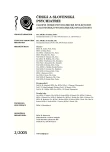-
Medical journals
- Career
Contribution to the Discussion about Dissociative States, Taking into Consideration the Work of Pierre Janet (1859 – 1947)
Authors: J. M. Nerad 1; L. Neradová 2
Authors‘ workplace: Stichting Centrum 45, Oegstgeest, Nizozemsko ; ředitel drs. J. W. Reerds, MBA Psychiatrická poliklinika Mentrum, Amsterdam, Nizozemsko 1; ředitel drs. W. Mulder 2
Published in: Čes. a slov. Psychiat., 101, 2005, No. 2, pp. 98-104.
Category: Comprehensive Reports
Overview
In the first instance is the attention payed to the ideas of Pierre Janet about dissociation, especially to the historical roots of his theory. There are quoted passages from Janet’s works concerning two historical books which he considers essential for his own dissociative theory. The first one is the work of J. J. Moreau (de Tours) “About Hashish and Mental Alienation” from 1845. J. J. Moreau (de Tours) was not only the member of the famous “Club of Hashishins” in Paris, he was also provider of hashish: introducing this drug to the Pleiad of French artists between 1840 and 1850 and using it for therapeutic purposes in the psychiatry. J. J. Moreau earned the nickname “Father of the modern psychopharmacology”. He was also the first one using the terms “mental dissolution” (désagregation psychologique) and “idées fixes”. The second important source of Janet’s dissociative theory is a completely unknown booklet by an anonymous called Gros Jean (Simple Simon) from 1855. This author describes “division of personality” with amnesia between the two states. Janet also passes criticism on Sigmund Freud, showing how Freud adopted his ideas without quoting him and in addition criticizing Freud’s pansexualism. From Pierre Janet there is only a small step to the neodissociative theory of Hilgard. The attitudes of Dutch therapists concerning the idea of “hidden observer” can be classified in three categories: acceptance, tolerance or rejection.
It is in Hilgard’s belief that hidden observer concerns vertical dissociation contrasting horizontal dissociation. Among the instruments for the measurement of dissociative disorders there is a very interesting “Dissociation Questionaire” (DIS-Q), developed and validated by Vanderlinden and collaborators in the Flemish part of Belgium and in The Netherlands in the first half of the nineties.Key words:
Pierre Janet, J. J. Moreau (de Tours), S. Freud, dissociations, “hidden observer”.
Labels
Addictology Paediatric psychiatry Psychiatry
Article was published inCzech and Slovak Psychiatry

2005 Issue 2-
All articles in this issue
- Psychosocial Stressors in Young Families from Brno and Znojmo Part II
- Prediction of Efficacy of Inpatient Treatment in Metamphetamine Dependence
- Pesso Boyden Psychomotor Therapy in the Treatment of Traumatized in Patients, Survivors of Second World War in the Former Dutch East Indies
- Safety and Tolerability of Second and Third Generation Antipsychotics
- Contribution to the Discussion about Dissociative States, Taking into Consideration the Work of Pierre Janet (1859 – 1947)
- Inpatient Treated for Addictive Diseases at Psychiatric Hospital Prague Bohnice 1994 – 2003
- Czech and Slovak Psychiatry
- Journal archive
- Current issue
- Online only
- About the journal
Most read in this issue- Safety and Tolerability of Second and Third Generation Antipsychotics
- Prediction of Efficacy of Inpatient Treatment in Metamphetamine Dependence
- Psychosocial Stressors in Young Families from Brno and Znojmo Part II
- Pesso Boyden Psychomotor Therapy in the Treatment of Traumatized in Patients, Survivors of Second World War in the Former Dutch East Indies
Login#ADS_BOTTOM_SCRIPTS#Forgotten passwordEnter the email address that you registered with. We will send you instructions on how to set a new password.
- Career

